Road signs are designed to be quick to read and easy to understand. Road signs throughout the world tend to be very similar, but there will be minor differences. If you have driven in another country it pays to familiarise yourself with the Australian road signs; if you are studying for your drivers knowledge test (DKT) you'll need to know them to pass. Road signs can be fixed or movable.
Almost all road signs fit into these main groups:
There are examples of each type of sign below but these are only a select sample of the many different signs on Australian roads as you will also encounter private signs, handheld signs (for example, a round stop sign at temporary road works) and special signs (such as signs warning of aircraft flying overhead, blasting areas near quarries, detours, workmen ahead, bridge under repair, etc). These will tend to be written out in full and therefore easy to understand.
Important: Local state road authorities may have special rules for drivers in specific areas. These restrictions should be indicated by special signs or markings and must be obeyed in that area.
Regulatory signs control traffic and must be obeyed.
They are almost always red and/or black on a white background.
 Give way - slow down and be prepared to stop
Give way - slow down and be prepared to stop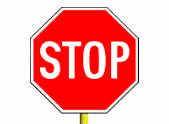 Stop (compulsory)
Stop (compulsory)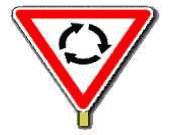 You are approaching a roundabout. Be prepared to give way
You are approaching a roundabout. Be prepared to give way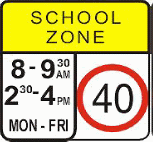 You must not go faster than 40km/h between 8-9:30am and 2:30-4pm
You must not go faster than 40km/h between 8-9:30am and 2:30-4pm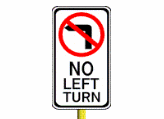 No left turn. You may also see this sign without the words
No left turn. You may also see this sign without the words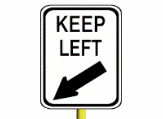 You must keep left
You must keep left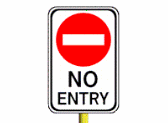 No entry
No entry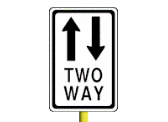 The road is two way, i.e. traffic will be approaching you in the right hand lane
The road is two way, i.e. traffic will be approaching you in the right hand lane The road is one way, to the left
The road is one way, to the left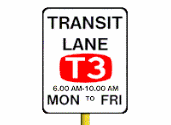 The lane is a transit lane limited to vehicles with three or more occupants between 6-10am, Monday to Friday
The lane is a transit lane limited to vehicles with three or more occupants between 6-10am, Monday to FridayWarning signs alert you to possible dangers ahead. They are usually yellow with black diagrams. They may indicate the presence of people (e.g. children, pedestrians) or animals (e.g. kangaroos, cassowaries), or a hidden change in the road ahead (e.g an approaching intersection or curve).
There are two types of warning signs:
Both types of warning signs are usually diamond shaped.
Permanent warning signs are yellow and black. They are usually placed at the beginning of an area of particular caution.
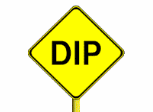 Unexpected or hidden dip in the road
Unexpected or hidden dip in the road
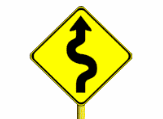 Winding road. This sign will often have a number of kilometres written underneath
Winding road. This sign will often have a number of kilometres written underneath
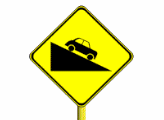 Steep downhill slope ahead. Take care with your brakes
Steep downhill slope ahead. Take care with your brakes
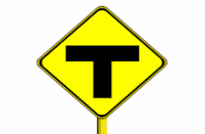 T-intersection ahead. Be prepared to slow down or stop and give way
T-intersection ahead. Be prepared to slow down or stop and give way
Temporary warning signs are also yellow and black, and sometimes orange and black. They are always placed at the beginning of an area where extra caution is presently required.
 Road works
Road works
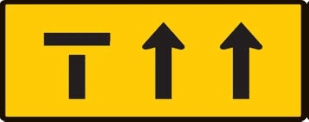 Left lane closed
Left lane closed
 Temporary warning triangle to warn of an incident ahead such as an accident or object partially blocking the road
Temporary warning triangle to warn of an incident ahead such as an accident or object partially blocking the road
Information signs inform you of relevant information for your journey, like distances to the next town, state highway numbers or special road conditions like low bridges. They are generally rectangular and come in a range of colours and sizes.
 Indicates the height available under a bridge or other obstacle
Indicates the height available under a bridge or other obstacle
 Road becomes a dual carraigeway
Road becomes a dual carraigeway
When oversize vehicles such as road trains or vehicles carrying very large loads use public roads, they must have special signage mounted on them. They may also be accompanied by pilot vehicles to warn other road users to be careful.
If you see one of these signs or a pilot vehicle when you are driving, you should slow down until it's safe to resume a normal speed. If the oversize vehicle or load is coming towards you, you may need to pull over and stop to allow it to pass by your vehicle.